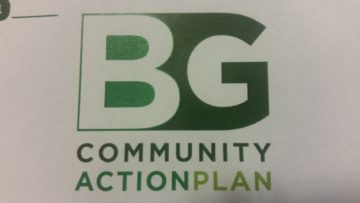By JAN LARSON McLAUGHLIN
BG Independent News
By the end of the evening, each table was cluttered with huge sheets of paper listing ideas to revitalize neighborhoods in Bowling Green. The suggestions were widely varied, but linked by one common desire of local residents – they want action.
“How many of you are sick of planning and want to see something happen?” asked Adam Rosa, from the consultant group Camiros, from Chicago. The question caused hands to shoot up around the Crim Elementary cafeteria, where nearly 100 people had gathered Tuesday to participate in the process.
Rosa then showed an image from the “Animal House” movie. “This is kind of the opposite of what we are going for,” he said. Instead, the goals are to increase the livability, opportunity, vitality and education of the community.
And to do that, the Camiros consultants need community input. “This is all about you telling us about your neighborhood,” Rosa said during the first public meeting of the revitalization process.
The Bowling Green Community Action Plan will focus on the East Side of the city, where the needs have been identified as the greatest. But the plan will be applied to all areas of the city, Rosa said.
Camiros has worked with the special challenges faced by university communities elsewhere, such as the homes to Notre Dame, Indiana State, University of Chicago, Bradley University and Lawrence University.
The city of Bowling Green was compared with Kent – showing very similar demographics in population, income levels and percentage of student rental units. Though the statistics were almost identical, the photographs from the two communities showed very different uses of open space, business sites and areas uniting the city to the campus. The photos from Kent showed a bike boulevard to connect the community and university, a “Poetry Park” on open space, and attractive businesses.

Logo selected by residents to represent planning process
During their initial observations of Bowling Green, the consultants noted a very livable urban area that creates and preserves the feeling of community. They noticed a walkable city, with historic qualities and strong businesses.
But they also saw a housing spectrum that lacked homes for young couples and seniors. They noticed the large number of faculty members who live outside the city.
While they saw many well kept properties, the consultants also saw housing stock being degraded, especially on the East Side. They suggested the need for more code and building enforcements. They estimated a $54 million loss in property values on the East Side, where most student rentals exist and most disorderly conduct complaints occur.
“You guys know all this,” Rosa said.
To get better acquainted with the community and residents’ desires for it, local citizens were asked to list community assets first. The lists were long, noting good parks, well-kept and friendly neighborhoods, nice downtown shops and restaurants, the ability to have a voice in the community, lots of culture, high volunteerism, beautiful architecture and good schools.
The residents were also asked to describe the negatives, listing the high number of homes chopped up into rentals, low quality homes, the lack of safe bike routes, strip malls being filled with cheap chain restaurants, absentee ownership of properties, inadequate enforcement of rules, lack of attention by the university and city to students living off campus, and the use of public land for a private golf course.
Next, they were asked to list “opportunities” in Bowling Green. Among the ideas were more housing options for young couples and retirees, a concierge to help people moving into the city, better use of open space, grants to help low income families with home improvements, biking routes, accountability by landowners, and open minds to change.
The next Community Action Plan meeting will be in October. But in between now and then, Camiros staff will work on reviewing the city’s zoning code and looking for ways it can be improved.
Residents were also asked to suggest other small scale actions that can be taken early on in the planning process. Ideas included neighborhood cleanups, block parties when student arrive back in town, and marketing campaigns to get people on board with the revitalization process.
When the meeting was nearly over, Les Pollock, the principal consultant with Camiros, offered his thoughts to the audience.
“I found tonight very interesting,” Pollock said. “Oftentimes were come to these meetings and we hear a lot about the problems.” But at Tuesday’s meeting, he also heard a lot of positives and “a real sense of community.”
“This isn’t a town with deep seated irreconcilable problems,” Pollock said.
Camiros representatives will be working on the Bowling Green plan over the next 10 months, coming up with a draft plan early next year, and a complete plan by next August. The city is paying the consulting group $90,000 for its work.
A task force will be meeting between now and the next public meeting. All progress on the plan will be noted on the city’s website under community action plan.

